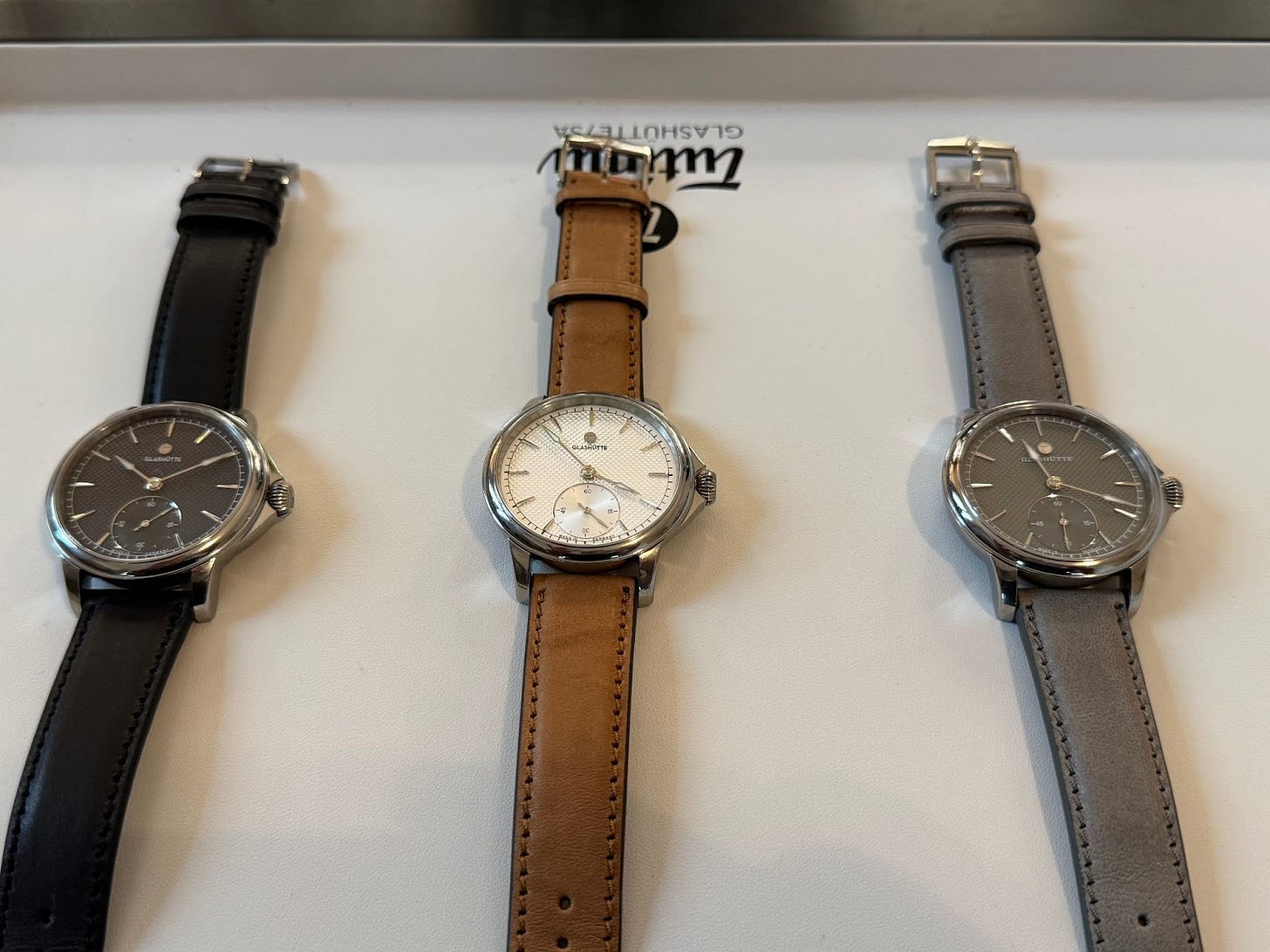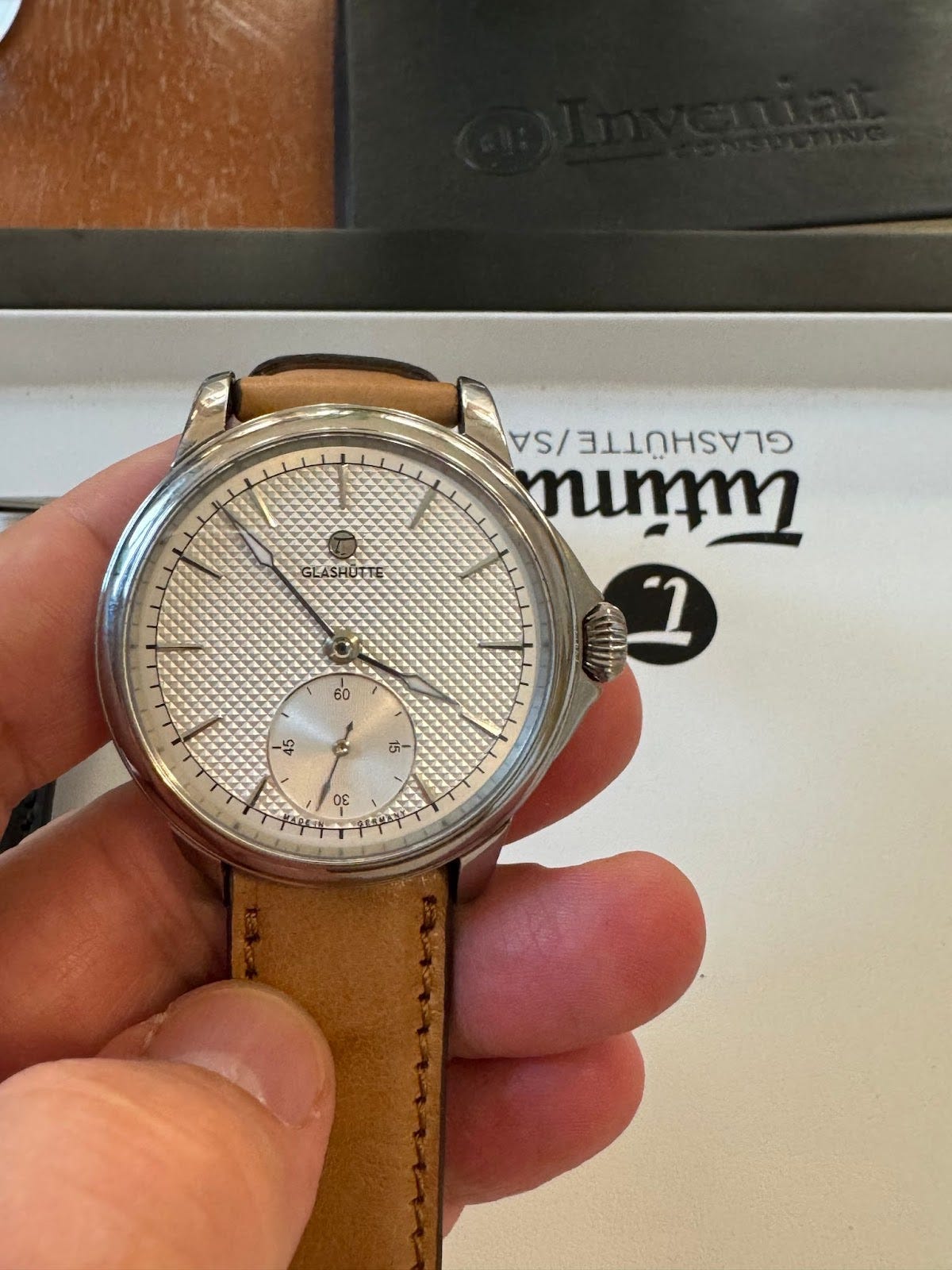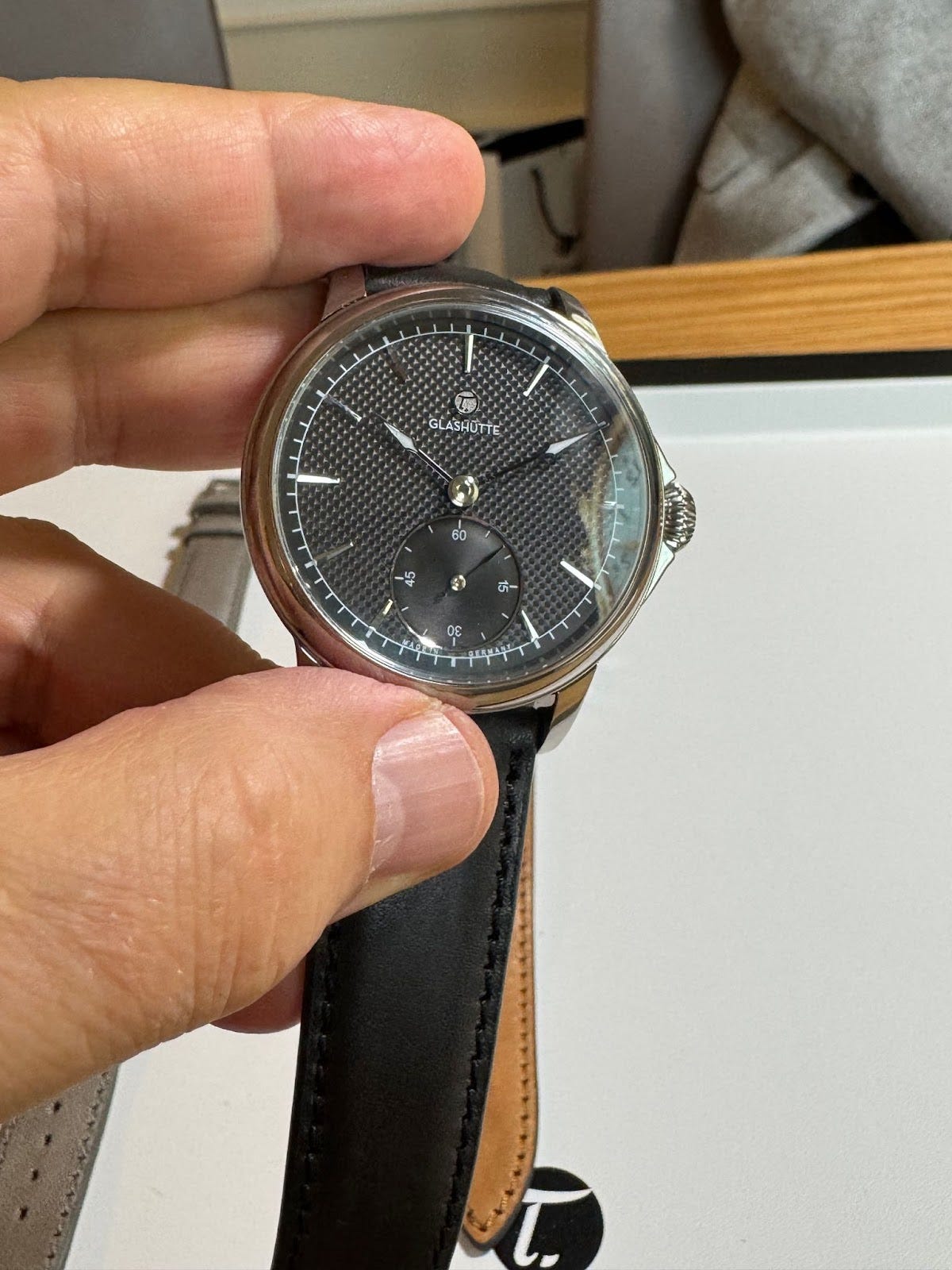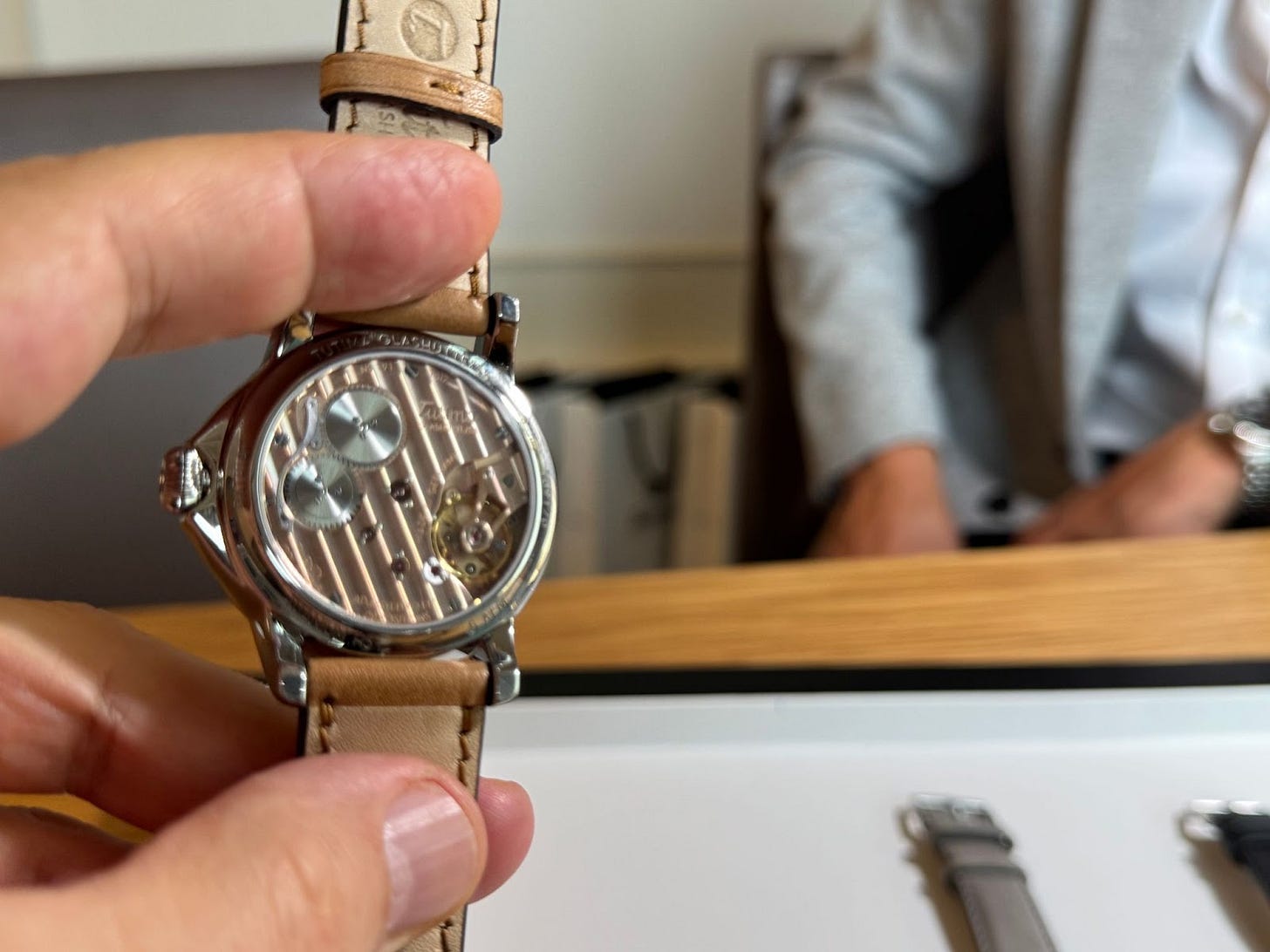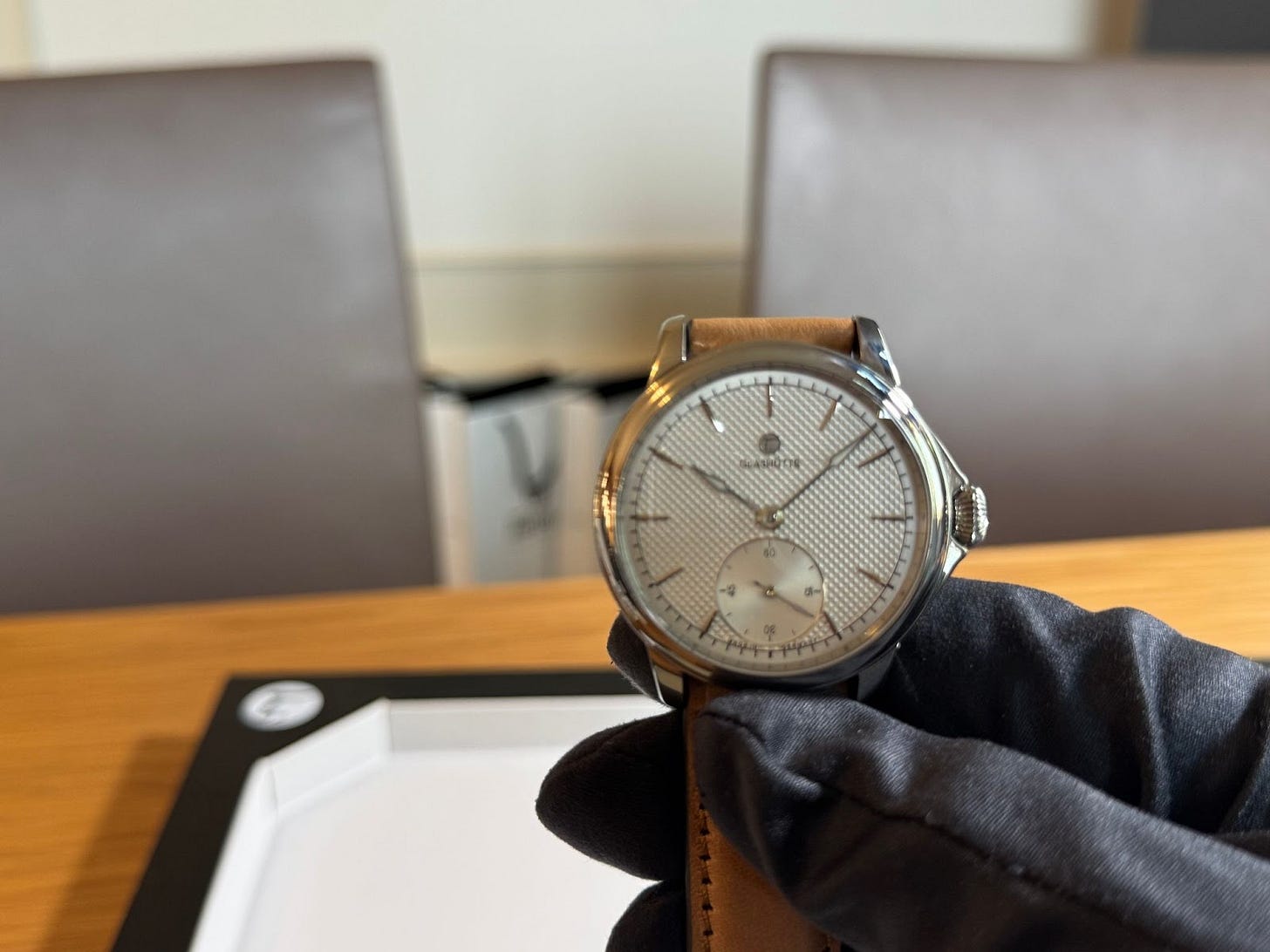Patria in Titanium: Seduction of Strength
Tutima’s new Patria emerges in titanium—light, resilient, and intimate. A watch that wraps Glashütte’s heritage in a body of modern temptation, balancing restraint and allure with quiet confidence.
A paradox beats beneath the polished titanium case: Tutima, famed for pragmatic pilot’s chronographs, now courts collectors with a delicately finished, hand-wound dress watch. This is a brand whose wartime chronographs once lived on the wrists of Luftwaffe aviators, whose later NATO chronographs became instruments of state. And yet here is Patria—its name a whisper of homeland, its form more salon than cockpit. The contradiction is delicious. Strength rendered light. Titanium masquerading as warmth. The utilitarian re-clothed as aristocrat. Other brands have dabbled in such inversions—Panerai’s bronze tool watches that became luxury showpieces, or IWC’s ceramic flieger reimagined for boardrooms. Tutima’s move feels riskier, because it asks us to believe that this most durable of German watchmakers can also seduce. For the collector, that tension is the forbidden fruit: discipline yielding to sensuality, reliability draped in the shimmer of lightness.
Tutima insists that an in-house caliber, the hand-wound 617, is the guarantee of authenticity. It is the mechanical anchor for Patria’s claims of heritage. Yet every seasoned collector knows the trick: in-house is not an absolute virtue but a theater of sovereignty. Outsourcing can yield equally fine results—Zenith El Primero chronographs in Rolex Daytonas, or Valjoux ébauches carrying brands for decades. Still, the 617 has weight. A three-quarter plate, Glashütte ribbing, a hand-bent Breguet overcoil—it is a movement that earns its adjectives. Tutima leans on it to say: “This is us, made at home, not borrowed.” The justification may be familiar marketing, but it is not empty. In a world where movements are increasingly modular, Tutima’s insistence on hand assembly and finishing is a reminder that watchmaking is not just engineering, but touch. The seduction lies precisely there: in-house not as a slogan, but as a caress.
What the press release cannot say plainly is that the Patria is meant to be wound like a lover’s lock of hair between the fingers. The crown, fluted and protected, slides under the skin of habit until winding becomes ritual. The recoiling click, the resistance yielding into release, transforms necessity into pleasure. Collectors live for these micro-rituals. Think of F.P. Journe owners describing the buttery glide of a remontoir, or Lange wearers obsessing over the sharp snap of a date change. Tutima now offers its own entry into this catalogue of seductions. The tactile intimacy of winding is what transforms the titanium case from mere metal into a partner in daily life. In that sense, Patria belongs less to aviation history and more to a tradition of sensual detail in watchmaking: details designed to make the collector complicit.
Tutima’s brochures extol “home,” “origin,” “values”—as though a Patria on the wrist could anchor identity in a drifting world. The watch is positioned as both shelter and statement. But the reality? Most will be worn in offices where titanium’s resistance to corrosion is irrelevant, or under dinner jackets where the lume will never blaze. And yet, that gap is not failure but allure. Luxury thrives on the fantasy that tools can transcend their use. Just as Rolex sells submariner’s steel to men who never dive, Tutima sells titanium to those who crave lightness not against gravity, but against time itself. The forbidden truth: collectors know they will not “need” the Patria. They want it precisely because it promises more than their daily life will ever demand.
Tutima’s mythology is heavy with survival. Born in Glashütte in 1927, destroyed in 1945, reconstituted in West Germany, then returned home after reunification. The very name—“safe, protected”—reads like a manifesto of endurance. Such narratives often risk cliché. Every brand invokes rebirth, resilience, heritage. But Tutima grounds myth in touchable craft. The gold chatons, the Glashütte ribbing, the manually bent Breguet overcoil: these are not myths but fingerprints. The mythology makes us lean in; the craft keeps us there. Seduction, after all, requires both story and proof. And in the Patria, proof glimmers beneath the sapphire back, reminding the skeptical collector that desire need not abandon evidence.
The Patria claims precision—21,600 vibrations per hour, 65 hours of reserve, hand regulation. But its true function is psychological. For a collector, winding it is not about power but about control. It offers the reassurance that time is not merely digital abstraction but something one must court, feed, and touch. Luxury psychology often reveals itself here. A hand-wound watch is a compact against chaos. In the act of winding, the collector asserts continuity: today, as yesterday, as tomorrow. Tutima’s language of “home” and “origins” becomes less metaphor and more mechanism. The seduction is not of precision, but of permanence—an illusion of rootedness in an age of drift.
What could be more absurd than regulating a balance with screws hand-polished by artisans in Glashütte, so that an executive in Hamburg may wear it beneath a French cuff? The seriousness of the craft and the banality of the setting collide. And yet in that absurdity lies the joy. Collectors secretly adore the tension between gravitas and frivolity. It is the same thrill that makes them discuss balance amplitudes over cocktails, or argue about Geneva stripes in the airport lounge. Tutima’s Patria offers itself to this theater, serious enough to merit discussion, sensual enough to make the discussion sparkle. Extravagant? Certainly. But all desire carries its absurdities.
Placed in the 2020s landscape, the Patria feels like Tutima’s seduction of modernity. While Rolex courts scarcity and Tudor revels in retro-cool, Tutima turns to titanium and handcraft as its double lure: resilience and intimacy. Among independents, it competes not with the baroque eccentricities of MB&F or the futurism of De Bethune, but with the sober sensuality of A. Lange & Söhne’s Saxonia or Moritz Grossmann’s Atum. Culturally, titanium has become the darling of design—a material that signals both futurism and discretion. From Apple’s titanium-clad iPhones to Bulgari’s Octo Finissimo, it is the metal of now. Tutima inserts itself into this conversation, suggesting that German solidity need not be heavy. The release reveals a broader truth: in the 2020s, even heritage brands must seduce, not just survive.
Author’s Opinion
The Patria in titanium is not flawless—it remains a calculated act of seduction, and some will resist. Yet it demonstrates a brand confident enough to transform its history into allure rather than burden. Tutima does not merely repeat its pilot’s past; it risks tenderness. As a collector, one may smile at the contradictions, savor the rituals, question the slogans. But the verdict is clear: the Patria is worth desire. To borrow a phrase, every watch is a mirror of its owner’s longings. This one reflects the longing for strength without weight, for heritage without heaviness, for intimacy in an age of distance. And that is a forbidden fruit many will not resist.



